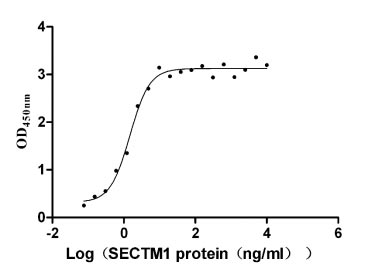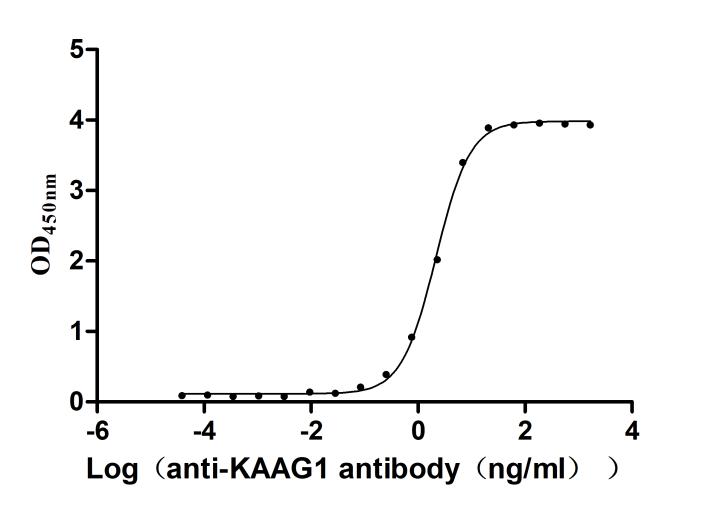Recombinant Human Krueppel-like factor 10 (KLF10)
-
货号:CSB-YP621651HU
-
规格:
-
来源:Yeast
-
其他:
-
货号:CSB-EP621651HU
-
规格:
-
来源:E.coli
-
其他:
-
货号:CSB-EP621651HU-B
-
规格:
-
来源:E.coli
-
共轭:Avi-tag Biotinylated
E. coli biotin ligase (BirA) is highly specific in covalently attaching biotin to the 15 amino acid AviTag peptide. This recombinant protein was biotinylated in vivo by AviTag-BirA technology, which method is BriA catalyzes amide linkage between the biotin and the specific lysine of the AviTag.
-
其他:
-
货号:CSB-BP621651HU
-
规格:
-
来源:Baculovirus
-
其他:
-
货号:CSB-MP621651HU
-
规格:
-
来源:Mammalian cell
-
其他:
产品详情
-
纯度:>85% (SDS-PAGE)
-
基因名:KLF10
-
Uniprot No.:
-
别名:Early growth response; alpha; Early growth response; alpha like; EGR A; EGR alpha ; EGR(A); EGR-alpha; EGRA; Egral; EGRalpha; Gdnfif; KLF 10; KLF10; KLF10_HUMAN; Krueppel like factor 10; Krueppel like factor10; Krueppel-like factor 10; Kruppel like factor 10; mGIF; TGF-beta- inducible early gene; TGFB inducible early growth response 1; TGFB inducible early growth response; TGFB inducible early growth response protein 1; TGFB-inducible early growth response protein 1; TIEG 1; TIEG; TIEG-1; TIEG1; Transforming growth factor beta inducible early growth response; Transforming growth factor beta inducible early growth response protein 1; Transforming growth factor-beta-inducible early growth response protein 1; Zinc finger transcription factor TIEG
-
种属:Homo sapiens (Human)
-
蛋白长度:full length protein
-
表达区域:1-480
-
氨基酸序列MLNFGASLQQ TAEERMEMIS ERPKESMYSW NKTAEKSDFE AVEALMSMSC SWKSDFKKYV ENRPVTPVSD LSEEENLLPG TPDFHTIPAF CLTPPYSPSD FEPSQVSNLM APAPSTVHFK SLSDTAKPHI AAPFKEEEKS PVSAPKLPKA QATSVIRHTA DAQLCNHQTC PMKAASILNY QNNSFRRRTH LNVEAARKNI PCAAVSPNRS KCERNTVADV DEKASAALYD FSVPSSETVI CRSQPAPVSP QQKSVLVSPP AVSAGGVPPM PVICQMVPLP ANNPVVTTVV PSTPPSQPPA VCPPVVFMGT QVPKGAVMFV VPQPVVQSSK PPVVSPNGTR LSPIAPAPGF SPSAAKVTPQ IDSSRIRSHI CSHPGCGKTY FKSSHLKAHT RTHTGEKPFS CSWKGCERRF ARSDELSRHR RTHTGEKKFA CPMCDRRFMR SDHLTKHARR HLSAKKLPNW QMEVSKLNDI ALPPTPAPTQ
-
蛋白标签:Tag type will be determined during the manufacturing process.
The tag type will be determined during production process. If you have specified tag type, please tell us and we will develop the specified tag preferentially. -
产品提供形式:Lyophilized powder
Note: We will preferentially ship the format that we have in stock, however, if you have any special requirement for the format, please remark your requirement when placing the order, we will prepare according to your demand. -
复溶:We recommend that this vial be briefly centrifuged prior to opening to bring the contents to the bottom. Please reconstitute protein in deionized sterile water to a concentration of 0.1-1.0 mg/mL.We recommend to add 5-50% of glycerol (final concentration) and aliquot for long-term storage at -20℃/-80℃. Our default final concentration of glycerol is 50%. Customers could use it as reference.
-
储存条件:Store at -20°C/-80°C upon receipt, aliquoting is necessary for mutiple use. Avoid repeated freeze-thaw cycles.
-
保质期:The shelf life is related to many factors, storage state, buffer ingredients, storage temperature and the stability of the protein itself.
Generally, the shelf life of liquid form is 6 months at -20°C/-80°C. The shelf life of lyophilized form is 12 months at -20°C/-80°C. -
货期:Delivery time may differ from different purchasing way or location, please kindly consult your local distributors for specific delivery time.Note: All of our proteins are default shipped with normal blue ice packs, if you request to ship with dry ice, please communicate with us in advance and extra fees will be charged.
-
注意事项:Repeated freezing and thawing is not recommended. Store working aliquots at 4°C for up to one week.
-
Datasheet :Please contact us to get it.
相关产品
靶点详情
-
功能:Transcriptional repressor which binds to the consensus sequence 5'-GGTGTG-3'. Plays a role in the regulation of the circadian clock; binds to the GC box sequence in the promoter of the core clock component ARTNL/BMAL1 and represses its transcriptional activity. Regulates the circadian expression of genes involved in lipogenesis, gluconeogenesis, and glycolysis in the liver. Represses the expression of PCK2, a rate-limiting step enzyme of gluconeogenesis. May play a role in the cell cycle regulation.
-
基因功能参考文献:
- Results from a study on gene expression variability markers in early-stage human embryos shows that KLF10 is a putative marker for the 3-day, 8-cell embryo stage. PMID: 26288249
- Zinc is capable of ameliorating the allogeneic immune reaction by enhancement of antigen-specific iTreg cells due to modulation of essential molecular targets by upregulation of Foxp3 and KLF-10 and downregulation of IRF-1. PMID: 27260002
- Thus, our study uncovers a novel regulatory mechanism underlying which KLF10 stability and its biological function are mediated by FBW7. PMID: 29198712
- In clinical specimens of lung adenocarcinoma, low KLF10 expression associated with decreased patient survival, consistent with a pivotal role for KLF10 in distinguishing the antiproliferative versus prometastatic functions of TGFbeta. Our results establish that KLF10 functions to suppress TGFb-induced EMT, establishing a molecular basis for the dichotomy of TGFb function during tumor progression. PMID: 28249899
- the findings show that TIEG1 is highly expressed in human keloids and that it directly binds and represses Smad7 promoter-mediated activation of TGF-beta/Smad2 signaling PMID: 28108300
- photoexposure decreases expression in fibroblasts and keratinocytes PMID: 26119394
- TIEG-1 overexpression in normal human skin fibroblasts results in improved resistance to oxidative stress PMID: 26922828
- CDK2 up-regulates the protein level of KLF10 through reducing its association with SIAH1, a KLF10 E3-ubiqutin ligase involved in proteasomal degradation. PMID: 25728284
- KLF10 directly binds to TGF-BRII promoter in T cells, leading to enhanced gene expression. PMID: 25472963
- The tumor suppressor function of LSAMP is most likely exerted by reducing the proliferation rate of the tumor cells, possibly by indirectly upregulating one or more of the genes HES1, CTAG2 or KLF10. PMID: 24885297
- KLF10, functions as a toggle to integrate antagonistic signals regulating FOXP3 via Sin3-HDAC/PCAF pathway and, thus, immune activation. PMID: 24944246
- RAF-1 phosphorylation and PIN1 isomerization together regulate KLF10 stability and further affect the role of KLF10 in tumor progression. PMID: 23994618
- KLF10 is an effective repressor of myoblast proliferation and represses FGFR1 promoter activity in these cells via an Sp1 binding site. PMID: 23569208
- KLF10 may constitute a pharmacogenomic marker to discriminate between response and nonresponse to hydroxyurea treatment in beta-hemoglobinopathy patients. PMID: 23057549
- KLF10 is a potential clinical predictor for progression of pancreatic cancer. PMID: 22688058
- study identified 6 novel, hypertrophic cardiomyopathy associated TIEG1 missense variants and have demonstrated that a number of these variants have abnormal function with regard to mutant TIEG1's ability to regulate either the PTTG1 or SMAD7 promoters PMID: 22234868
- TIEG1 inhibits breast cancer cell invasion by inhibition of the EGFR signaling pathway. PMID: 22025675
- TIEG1 has a role in regulating the expression and activity of Runx2 in osteoblasts PMID: 21559363
- KLF10 is upregulated in human PDLCs subjected to tensile stress related to mechano-induced cell cycle arrest. PMID: 20934684
- Results indicate that HPV-16 oncoprotein E7 binds to the C-terminus of TIEG1 and induces its degradation via the ubiquitin pathway. E7 not only increased the ubiquitination of TIEG1 but also influenced the ability of TIEG1 to affect apoptosis. PMID: 20691807
- JARID1B is the first TIEG1 corepressor identified, explaining how TIEG1 represses transcription through inducing histone H3 lysine 4 demethylation, which may be important for TIEG1 function in both normal and cancer cells. PMID: 20863814
- KLF10 has been shown to play a major role in the TGFbeta inhibition of cell proliferation and inflammation and induction of apoptosis, and its overexpression in human osteoblasts and pancreatic carcinoma cells mimics the actions of TGFbeta[review] PMID: 20087894
- no sequence alterations or alterations in expression were found in TIEG1 in pancreatic cancer; an essential role of TIEG1 in pancreatic cancer can be excluded PMID: 12065093
- TIEG amplies Smad signaling. PMID: 12173049
- Up-regulation of CD11d expression following differentiation of myeloid cells is mediated through increased binding of TIEG1 binding to the CD11d promoter. PMID: 15087465
- Differential gene expression of TIEG, a tumor suppressor gene, plays a significant role in the proliferation of breast cancer PMID: 15218362
- Expression of TIEG is known to inhibit Smad7 expression in bronchial epithelial cells. PMID: 17377371
- TIEG1 induces apoptosis through mitochondrial apoptotic pathway and promotes apoptosis induced by homoharringtonine and velcade. PMID: 17659279
- Gene variants may weakly contribute to a particular genetic background that increases the susceptibility to development of type 2 diabetes. PMID: 17931948
- TIEG is rapidly induced in response to estrogen in osteoblasts by ERbeta, but not ERalpha PMID: 18483178
- Data suggest that TGFbeta and BMP-6 in the bone marrow microenvironment allow leukemia cells to escape therapy. Further, the data indicate that TIEG1 might be involved in mediating this effect from the microenvironment onto the leukemia cells. PMID: 18798273
显示更多
收起更多
-
亚细胞定位:Nucleus.
-
蛋白家族:Sp1 C2H2-type zinc-finger protein family
-
数据库链接:
HGNC: 11810
OMIM: 601878
KEGG: hsa:7071
STRING: 9606.ENSP00000285407
UniGene: Hs.435001
Most popular with customers
-
Recombinant Human T-cell antigen CD7 (CD7), partial (Active)
Express system: Mammalian cell
Species: Homo sapiens (Human)
-
Recombinant Human Tumor-associated calcium signal transducer 2 (TACSTD2), partial (Active)
Express system: Mammalian cell
Species: Homo sapiens (Human)
-
Recombinant Human Kidney-associated antigen 1(KAAG1) (Active)
Express system: E.coli
Species: Homo sapiens (Human)
-
Express system: Mammalian cell
Species: Homo sapiens (Human)
















